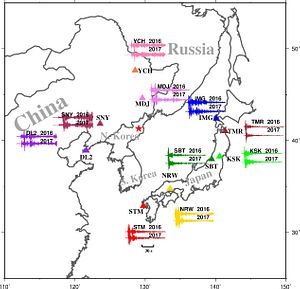North Korea’s latest nuclear test has caused strong tremors — both physically and mentally– in China.
On Sunday, September 3, North Korea conducted its sixth nuclear test, detonating a powerful nuclear device in one of its underground nuclear testing sites close to the Chinese border. The explosion caused a strong tremor in China’s northern area. China’s Ministry of Environmental Protection on September 3 announced the activation of its “nuclear radiation environment related contingency plans.”
According to the China Earthquake Administration’s initial report, the explosion generated a tremble equal to a 6.3 earthquake and was strongly felt in multiple areas in northeast China including Yanji, Jilin City, Changchun City, Baishan City and the Changbai mountain area. The tremor lasted for about 8 seconds.
As The Diplomat reported earlier, the unexpected shaking was noticed by many Chinese. Some Chinese netizens harshly criticized Pyongyang as well as Beijing, although many of the critical comments have since been deleted by Chinese censors.
At 11:46 a.m. on September 3, China’s Ministry of Environmental Protection launched their “nuclear radiation environment related contingency plans” and declared that China had entered into its “second-degree emergency” status. The ministry has carried out emergency monitoring and analysis of artificial radioactive nuclide samples collected in all four provinces — Jilin, Heilongjiang, Liaoning, and Shandong — surrounding North Korea.
By September 5, the Ministry had released nine statements with the latest analysis results, a clear effort to calm public nerves with information. It’s worth noting that the wording of each statement’s conclusion is very scientific and cautious:
By now, the latest North Korea’s nuclear test hasn’t affected our environment and public yet.
On September 5, the ministry gathered other relevant departments including water resource, sanitation, traffic, weather, earthquake, the central military commission, and the armed police headquarters to “comprehensively strengthen” the radiation environment monitoring across the border. The analysis also expanded to drinking water, surface water, groundwater and soil, rather than air alone. The ministry also promised to conduct 24-hour monitoring and release the results to public instantly.
However, the public panic hasn’t completely quieted down yet.
On September 4, University of Science and Technology of China — one of China’s national research universities under the direct leadership of the Chinese Academy of Sciences — released a detailed report, claiming that “the power of the latest North Korea’s nuclear test is 3 to 7.8 times stronger than that of the Nagasaki atomic bomb — Fat Man — dropped by the United States in 1945.”
China’s netizens also started to share self-protection guidebooks on nuclear blast and nuclear radiation on Weibo.

































